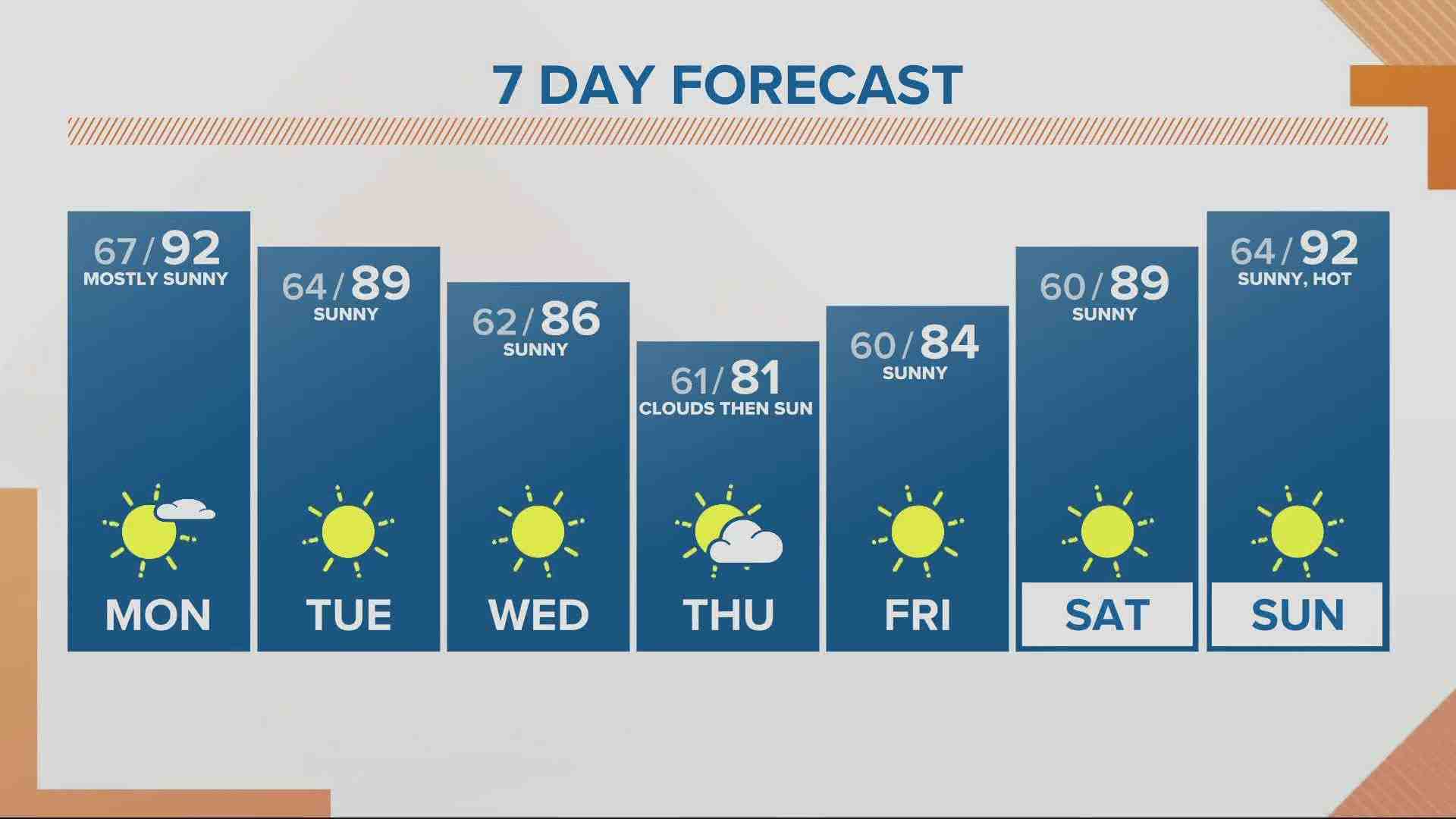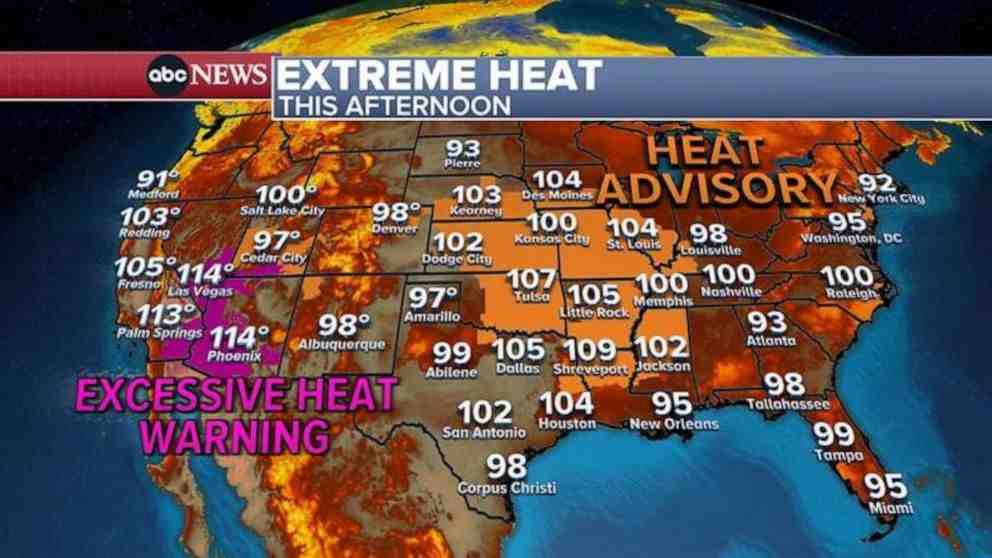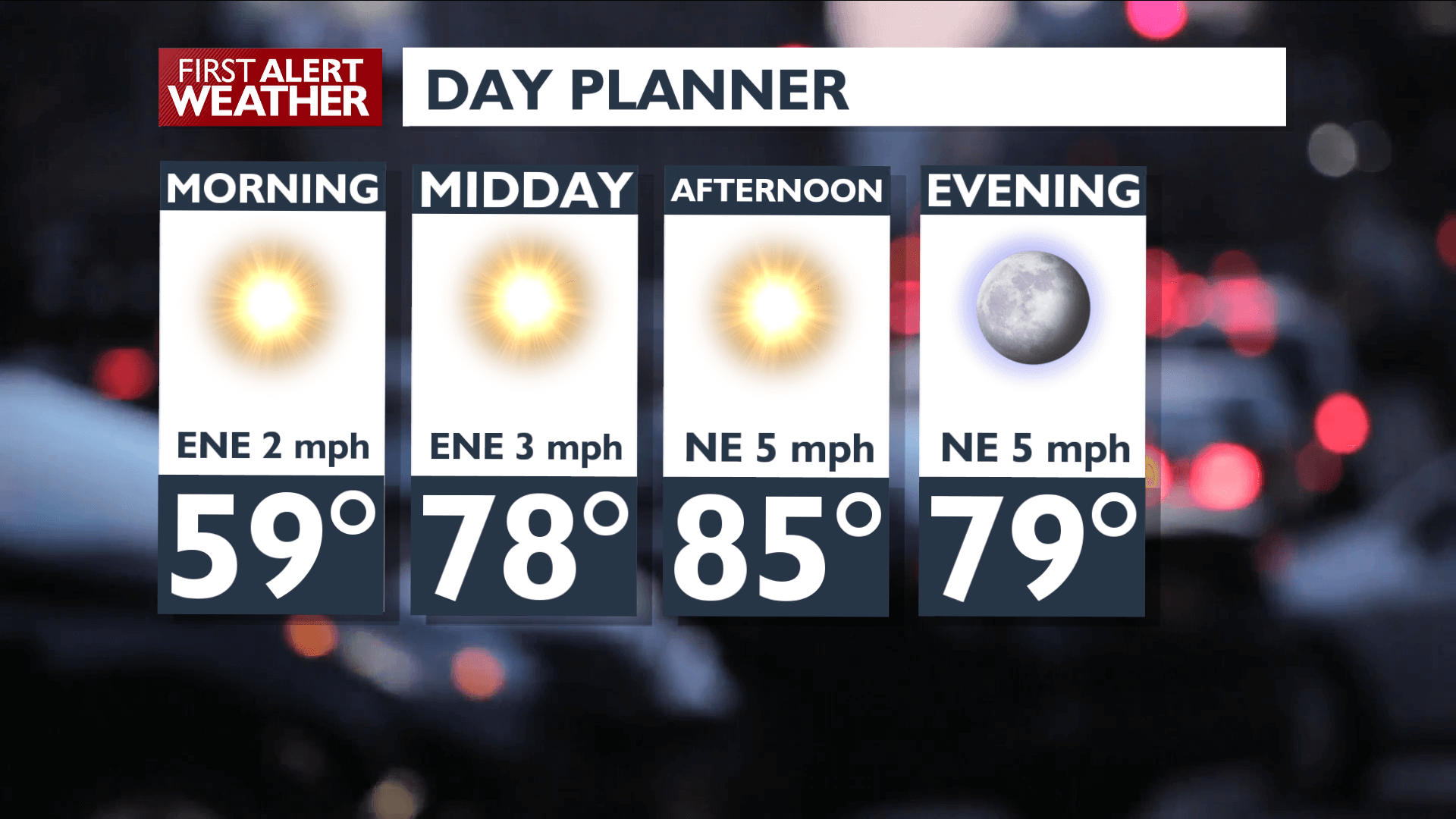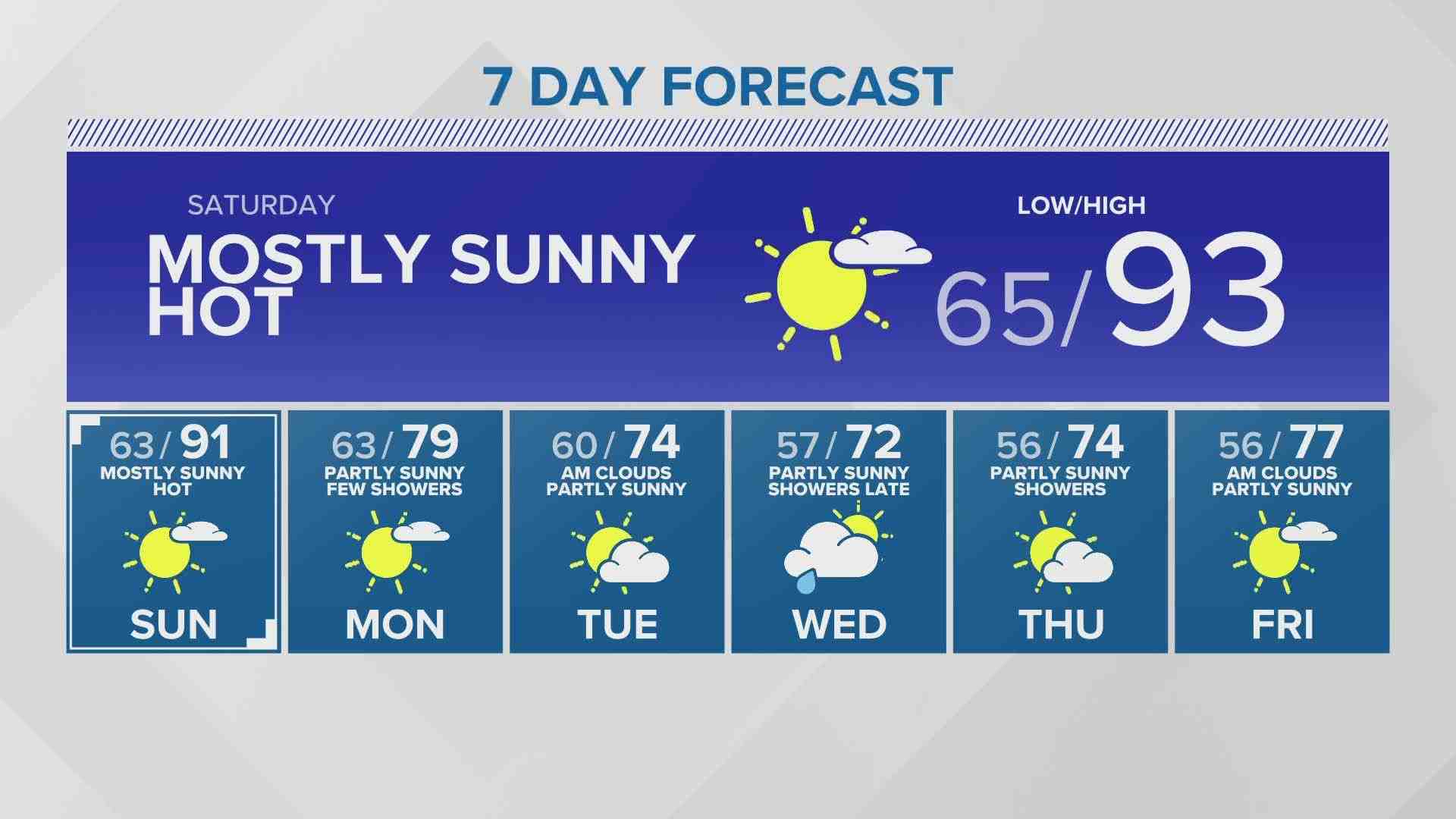A long and possibly record-breaking heat wave is expected to hit California this week, with temperatures in the low 90s and 100s Wednesday with little relief expected overnight, according to the National Weather Service.
“There is a large dome of high pressure over the Great Basin and it will move west over California tomorrow and Thursday and cause temperatures to rise well above normal,” National Weather Service meteorologist David Spector said .
A map of the United States on the National Weather Service website shows most of Northern California under an excessive heat advisory, while Southern California is under an excessive heat advisory as temperatures could exceed 110 degrees in the next few days.
Counties under excessive heat warnings include Los Angeles, where temperatures of up to 115 degrees can be expected, and San Diego, where temperatures could reach 109 degrees. The heat advisory is in effect from Wednesday through Monday, the National Weather Service said.
Parts of southern Nevada and western Arizona are also under an excessive heat warning Tuesday through Sunday and will experience temperatures 8 to 12 degrees above normal.
In Northern California, where an excessive heat wave is in place Saturday through Tuesday, Sacramento, the San Francisco Bay Area and other areas could experience record temperatures of up to 115 degrees.
In the Pacific Northwest, parts of eastern Washington, eastern Oregon and southwestern Idaho are under heat warnings, meaning temperatures could reach 105 degrees. Scorching conditions could intensify the Rum Creek Fire in Oregon, which has burned more than 11,000 acres.
An air quality alert was issued for Maricopa County, Arizona because “weather conditions combined with existing ozone levels are expected to produce local maximum ozone concentrations within 8 hours that pose a risk to to health,” the weather service said.
About 52 million people are under heat warnings in the Southwest, Southern California and the Pacific Northwest. Records could be broken across the region on Tuesday.
The National Weather Service warned that the extreme heat “will significantly increase the potential for heat-related illness, especially for those who work or participate in outdoor activities.”
“It’s going to be dangerous outside for a long period of time, especially for the elderly and pets,” Spector said.
Heat kills more people annually in the United States than other weather disasters, such as floods, hurricanes and tornadoes. It is recommended to drink plenty of fluids and stay indoors.
The hot, dry conditions also mean a high fire risk in California, which has already seen several wildfires this year, including the deadly McKinney Fire, the state’s largest blaze of the year.
Dangerously hot conditions could also worsen the state’s historic drought.
“In terms of the drought, it’s only going to get worse,” Spector said. “Dry moisture will make conditions even drier.”
Mirna Alsharif is a breaking news reporter for NBC News.
The summers of 2021 and 1936 take first and second place, followed by 2012, 2011 and 2020, respectively. In fact, eight of the 10 hottest summers in the contiguous United States have occurred in the 21st century, according to NOAA. The only two that are not from this century are 1934 and 1936.
What was the deadliest heat wave ever?

Here is a list of the deadliest heat waves in history:
- 1- Heat wave in Europe in 2003.
- 2- Heat wave in Russia in 2010.
- 3- Heat wave in the eastern United States in 1901.
- 4- Heat wave in America and Canada in 1936.
- 5- A heat wave affected the United States in 1980.
- 6- The heat wave in India in 2015.
Is 2022 the hottest summer on record? According to NOAA’s National Centers for Environmental Information, July 2022 was the sixth hottest July on record.
How hot was the 1936 heat wave?
The all-time high of 113 degrees was reported on the 15th, breaking the previous all-time record by 6 degrees. In 1936 there were 23 days that recorded highs of 100 degrees or more. This includes 14 consecutive days from the 4th to the 17th.
How hot was the summer of 1936?
The climatological summer (June–August) of 1936 remains the warmest on record nationwide (since 1895) with an average temperature of 74.0°F. (The second warmest summer was 2012 with an average of 73.7°F.)
What is the hottest heat wave in history?
1913: In July, the hottest heat wave ever hit California. During this heat wave, Death Valley recorded a record temperature of 57 °C (134 °F) at Furnace Creek, which remains the highest recorded ambient air temperature on Earth.
When was the big heat wave that killed so many people?
1936 North American heat wave North America has been affected by several major heat waves. The one that struck in 1936 is considered the worst in modern US history. The timing of this was also terrible. It took place during a time when the United States and Canada were in the midst of the Great Depression.
Why was 1936 so hot?
Without vegetation and soil moisture, the Plains acted like an oven. The climate of that region acquired desert qualities, accentuating its ability to produce heat. A strong ridge of high pressure settled over the West Coast and channeled heat northward across the Upper Midwest and Great Lakes.
What was the worst heat wave in America?
For an answer, it is instructive to look to one of the worst heat waves in modern history: the American heat wave of 1936. Even by the scorched and sweaty standards of 2022, the heat wave of 1936 produced astonishing numbers all over the world. southeastern, central, and western regions of the United States.
How long did 1976 heatwave last?
Effects of heatwave and drought Heathrow had 16 consecutive days above 30°C (86°F) from 23 June to 8 July and for 15 consecutive days from 23 June to 7 July temperatures they reached 32.2 °C (90 °F) somewhere in England.
How long did the longest heat wave last?
The longest continuous string of 38 °C (100 °F) or higher temperatures was reached for 101 days in Yuma, Arizona during 1937, and the highest temperatures ever reached in Canada were recorded at two locations in Saskatchewan in July 1937
How long did the 1976 drought last?
A paper published in Nature that year by two Met Office scientists states that rainfall in England and Wales during 1971-1975 was the lowest for any five-year period since the 1850s. the period between May 1975 and August 1976 was the driest since records began in 1717.
How hot was the summer of 1954?

Temperatures reached 43.9 °C (111 °F) on July 13, 1954 and 44.4 °C (112 °F) on July 14, 1954 in Kansas City. There were 15 days in July with temperatures of 37.8 °C (100 °F) or higher, and 7 days in August (3–4, 15–17, and 28–29). Prior to 1954, August record highs had been below 100 °F (37.8 °C) in Kansas City.
What was the hottest day in 1954? July 14, 1954: The hottest day in St.
What is the hottest summer in recorded history?
The contiguous United States just recorded its hottest summer on record, beating the previous record set in 1936 by less than one-hundredth, the National Oceanic and Atmospheric Administration found in a recent climate report.
Which was the hottest year in human history?
The year was 1988. Global temperatures were about 0.6 degrees Celsius (1.1 degrees Fahrenheit) above the pre-industrial average.
What was the hottest summer on record?
August 2011 was not only the warmest August, but also the hottest month on record at Camp Mabry. The average high temperature was 104.8 degrees. The overall average temperature was 91.7. August is historically when we experience our warmest conditions of the entire year.
Was July the hottest month on record?
This made it the sixth warmest July in the 143-year global climate record. July marked the 46th consecutive July and the 451st consecutive month with temperatures above the 20th century average.
Which year was the hottest on record?
The seven warmest years have all been since 2015, with 2016, 2019 and 2020 making up the top three. An exceptionally strong El Niño event occurred in 2016, contributing to record average global warming.
What was Earth’s hottest month on record?
July 2021 has earned the unenviable distinction of being the world’s hottest month on record, according to new global data released today by NOAA’s National Centers for Environmental Information.
What was the weather like in summer 1954?
Temperatures routinely exceeded 100 degrees during the summer of 1954. It was exacerbated by a series of hot, dry years. In parts of the Midwest in 1953, rainfall was as much as 16 inches below normal. The severe drought continued well into 1954, affecting 11 states from the Great Plains to the mid-South.
How hot was the summer of 1954?
Temperatures reached 43.9 °C (111 °F) on July 13, 1954 and 44.4 °C (112 °F) on July 14, 1954 in Kansas City. There were 15 days in July with temperatures of 37.8 °C (100 °F) or higher, and 7 days in August (3–4, 15–17, and 28–29). Prior to 1954, August record highs had been below 100 °F (37.8 °C) in Kansas City.
What is the hottest it’s ever been in St. Louis?
The all-time record high temperature stands at 115 degrees set back on July 14, 1954. St. Louis saw three consecutive record temperatures of 105 degrees or higher through the end of June 2012.
What temperature is too hot for humans?

People often point to a study published in 2010 that estimated that a wet-bulb temperature of 35 C, equal to 95 F at 100 percent humidity, or 115 F at 50 percent humidity, would be the safe upper limit , beyond which the human body can no longer cool itself by evaporating sweat from the body’s surface to…
What temperature is dangerously hot? In the 90Ë and 105ËF (32Ë and 40ËC) range, you may experience hot flashes and exhaustion. Between 105Ë and 130ËF (40Ë and 54ËC), heat exhaustion is more likely. You should limit your activities to this range. An ambient temperature above 130 ËF (54 ËC) often causes heat stroke.
Is 105 too hot to be outside?
If the outside temperature is between 90 and 105 F, it can cause hot flashes. If between 105 and 130 F, heat exhaustion can occur. If it is above 130 F, it can cause heat stroke. When things get to this point, there may be loss of consciousness, the skin may turn red, there may be nausea, vomiting, dizziness and other symptoms.
Why does my vape say Device too hot?
If your vapor is too hot, it’s likely an airflow and wattage issue. High wattage can result in hot vapor, but if you open the airflow slightly to allow more air to mix in, this should cool the vapor you inhale.
What happens if my vape gets too hot?
A hot vape tank can really slow down your vape routine. If a tank gets hot enough, the mouthpiece can become quite uncomfortable against the lips. In some cases, you may feel the heat from your tank radiating into the body of your vaping device – and this can be a concern.
What happens if a human gets too hot?
Without treatment, heat exhaustion can lead to heat stroke, a life-threatening condition that occurs when the core body temperature reaches 104 F (40 C) or higher. Heatstroke requires immediate medical attention to prevent permanent damage to the brain and other vital organs that can lead to death.
What temperature is too hot for humans to live?
People often point to a study published in 2010 that estimated a wet-bulb temperature of 35°C equivalent to 95°F at 100% humidity, or 115°F at 50% humidity, would be the upper limit of security. beyond which the human body can no longer cool itself by evaporating sweat from the surface of the body to…
What temperature is unbearable for humans?
A wet-bulb temperature of 35 °C (equal to 95 °F at 100% humidity or 115 °F at 50% humidity) was widely believed to be the maximum a human could withstand before could not adequately regulate its body temperature. , which could cause heat stroke or death with prolonged exposure.
What year did we have the hottest summer?

The average temperature this summer in the contiguous United States was 74 degrees, beating by less than a hundredth of a degree the record set in the summer of 1936, when scorching heat killed thousands of Americans and a catastrophic crop failure.
What is the hottest summer on record? The highest temperature ever recorded in the United States was 134 degrees in Death Valley, California on July 10, 1913. This is also the hottest temperature ever recorded on Earth. In the central United States, most of the Plains states have turned at least 120 degrees.
Is 2021 summer the hottest ever recorded?
Monthly climate reports from the US National Oceanic and Atmospheric Administration showed that the average temperature during the meteorological summer (June to August) of 2021 was the hottest on record at 74 °F, which was 2.6 °F above average.
Is summer 2018 hotter than 1976?
| area | |
| To mean | real °C |
| temperature | name |
| Rainfall | actual mm |
| Anom% |
How often are the Summer Olympics usually held?
Since then, the Summer Games and the Winter Games have been held every four years, but the Summer Games are held in the first year of an Olympics and the Winter Games are held in the third year. More information: Factsheet: The Games of the Olympiad. Information sheet: The Winter Olympics.
Where will the Summer Olympics to be held in year 2024?
The Session of the International Olympic Committee (IOC) meeting in Lima, Peru, chose Paris as the host city of the Games of the XXXIII Olympiad 2024 and Los Angeles as the host city of the Games of the XXXIV Olympiad 2028. “Congratulations to Paris 2024. and Los Angeles 2028!

